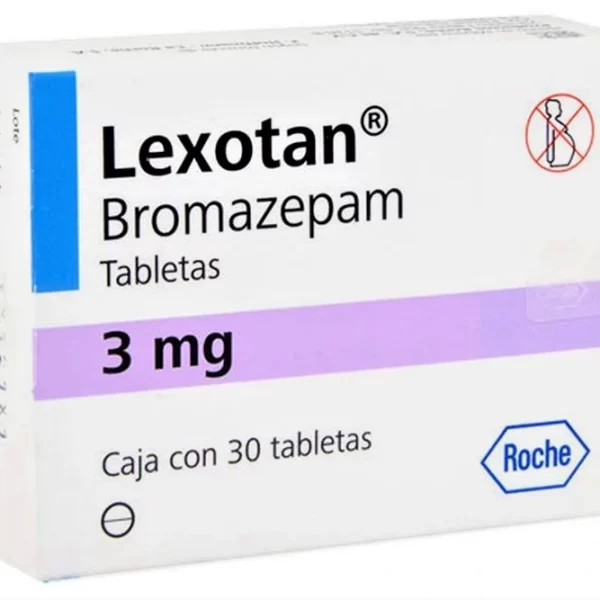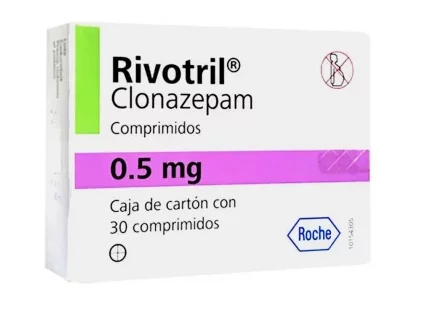Description
Bromazepam is a medication that is prescribed for anxiety states and has a sedative effect. It has a positive effect on sleep (easy falling asleep, reduction of night awakenings and nightmares, increase in sleep duration). Bromazepam – refers to anxiolytics (tranquilizers) for relief from anxiety, fears, and personality disorders.
Pharmaceutical action
After taking Bromazepam, the drug is quickly and completely absorbed from the stomach into the blood. Its effects occur within 1-2 hours, depending on how the body perceives the drug, and it remains active for 12 hours. It is excreted in the urine and intensively metabolized in the liver.
The drug, used for the first time, requires mandatory consultation with medical professionals.
It is forbidden to use Bromazepam simultaneously with opioids (strong analgesics), alcohol and narcotic substances. In this case, it is necessary to clean the stomach by lavage, induce vomiting, take enterosorbents, and monitor breathing, pulse, blood pressure, cardiovascular system, airway patency. It is recommended to consult a physician.
It may cause tolerance to the drug, allergic reactions of the body, occurrence of depression (ups and downs of mood), drowsiness, memory or sleep disorders, suicidal thoughts. You should consult your doctor in case of the above symptoms or changes in body condition.
Effects of Bromazepam during sleep
In a study of the effects of Bromazepam, it was found that the use of a low dose of the drug (1.5 mg 30 minutes before sleep) resulted in a decrease in the phase of falling asleep. A significant decrease in slow-wave sleep was also observed. The effect persists even after the end of the course. The effect persists even after the end of the course. Nocturnal nightmares and sleep interruptions occurred less frequently. If this product does not meet your needs or interests, you may want to look at Lyrica Pregabalin Generic 28 Tabs. Please visit this link for further information on our Anticonvulsant Drugs
Directions for use and dosages
In our online Pharmacy you can buy Bromazepam 3 mg; 6 and 1.5 mg. Bromazepam has an anxiolytic effect (reduction of fear, anxiety, and emotional tension), muscle relaxant, and sedative effect.
The dosage for adults in outpatient treatment is from 1.5 to 3 mg 2-3 times per day. Elderly patients, children under 18 years of age, pregnant and nursing patients, and patients with impaired hepatic and renal function should consult a GP to determine the dose.
The total duration of treatment is not more than 1-2 months, including a period of gradual reduction of the dose. A longer course may cause drug dependence. Taking Bromazepam does not depend on food intake.
Bromazepam: Side effects
- Drowsiness, dizziness, fatigue, headache
- Activity during sleep
- Depression, irritability, hallucinations, emotional dulling, confusion, and decreased concentration
- Chills, elevated body temperature, sore throat, weakness, anemia, thrombocytopenia
- Abundant or dry saliva, decreased appetite, jaundice, liver and kidney dysfunction, vomiting, heartburn, nausea, difficulty emptying the stomach or frequent liquid stools, and urinary disorders.
- Skin rash, itching, hypotension, abnormal heart rhythms, cardiac arrest
- Visual disturbances (blurry, blurred vision)
- Muscle weakness, cramps
- Rarely weight loss and decreased libido
Bromazepam: half-life
After ingestion, about 85% of Bromazepam 3 mg is absorbed in the intestine and reaches its highest level in the blood after about two hours. The active ingredient is broken down in the liver, and half is eliminated from the body in about 11 to 22 hours.
The elimination of half-life may be longer in older patients because excretion slows down. For this reason, a lower dose is often necessary for the elderly.
Contraindications to use
The drug should not be used in cases:
- During pregnancy and lactation
- Known dependence on it
- Sleep apnea syndrome
- Severe hepatic insufficiency
- Closed-angle glaucoma
- Coma, shock, myasthenia gravis (Abnormal muscle weakness)
- Alcohol or drug poisoning
- Respiratory insufficiency (Difficulty in breathing)
- Excessively depressed state (depression)
- Hypersensitivity to benzodiazepines
Special directions
Do not drive vehicles and machines while taking this medicine. Use with caution in the following conditions:
- Impaired liver and kidney function
- Motility disorder
- Medication abuse with mental illness
- Epilepsy (doses of anticonvulsants may need to be adjusted)
- Nocturnal breathing disorder
- Hypoproteinemia (a condition in which the protein level in the blood fluid is abnormally low)
- Abuse of drugs
If Bromazepam is used for a long time, regular blood tests and liver tests should be performed.
Interactions of bromazepam with other drugs
Increased respiratory depression and sedation may occur if other central nervous system-acting substances are taken concomitantly. These include:
- active agents against schizophrenia and psychosis;
- sedatives, sleeping pills;
- antidepressants;
- anesthetics;
- sedatives;
- anticonvulsants, allergy medications (anti-allergy);
- alcohol.
Other drugs that are broken down by the same liver enzyme systems (cytochrome P450) as Bromazepam may delay its breakdown. This enhances and prolongs the effects of Bromazepam.
Such active agents include, for example, Cimetidine and Omeprazole as well as many other substances. You should therefore ask your doctor or pharmacist in advance about possible interactions with other medicinal products.
When Bromazepam is used with Metoprolol or Fluvoxamine, the drug increases its effect on systolic BP and increases the plasma saturation of active substances. However, if it is necessary to use the drug simultaneously with other medications and vitamin supplements, it can be managed by adjusting or timing the intake.
Bromazepam vs Lorazepam
If compare these drugs, there are the following conclusions. While Lorazepam is more effective and has fewer contraindications, Bromazepam is safer, more convenient to use, has fewer side effects, and is less addictive. However, each treating physician determines which drug to prescribe in each case.
Bromazepam vs Alprazolam (Xanax)
Bromazepam and Alprazolam (Xanax) are both benzodiazepines used to treat anxiety, and they are all equally effective in use.
The main differences between Bromazepam and Alprazolam (Xanax):
- In Alprazolam and Xanax, the active ingredient is Alprazolam; in Bromazepam, the active ingredient is Bromazepam.
- Alprazolam and Xanax have a quicker onset of action, but a shorter duration of action (4 to 6 hours) compared to 10 hours of Bromazepam.
- Sedative, as well as performance-enhancing effects, may occur earlier when taking Xanax and Alprazolam, but disappear more quickly than in the case of taking Bromazepam.
Storage conditions
Store the preparation Bromazepam in a dry place, where it will not be exposed to strong heat, moisture, or direct sunlight at temperatures not exceeding +25 °C for not more than 5 years from the date of production. Restrict children’s access to the drug.
Indications:
Bromazepam is an anxiolytic medication that is effective in treating a range of disorders, including psychosomatic disorders, phobic tension anxiety, and hypochondriacal appearances. It is also useful in managing symptoms of pressure and tension, on edge despondency nervousness, and sleep deprivation. Additionally, it can be used to address respiratory and cardiovascular issues, such as Seudoangina pectoris, midsection torment, tachycardia, enthusiastic hypertension, dyspnea, hyperventilation, as well as gastrointestinal disturbances like irritable inside disorder and apprehensive diarrhea. Genitourinary issues, such as neurogenic bladder, can also be treated with bromazepam. Psychosomatic symptoms, including migraines and psychogenic dermatosis, bronchial asthma, peptic ulcer, ulcerative colitis, depression, phobic uneasiness, and hypochondriacal appearances, can also be managed with this medication.
Contraindications:
Bromazepam should not be used in patients with myasthenia gravis or shock, or in those who are sensitive to benzodiazepines. It is also contraindicated in the first trimester of pregnancy, in breastfeeding mothers, and in children under 2 years of age. It should not be used as the primary treatment for manic disorders, or in patients with liver failure, alcoholism, or drug dependence.



















Reviews
There are no reviews yet.